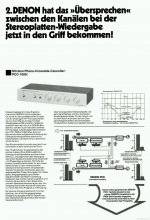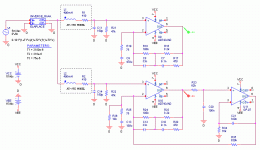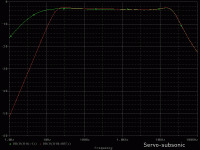Does that mean that your hypothesis is that Shure specifies a rather high recommended load capacitance for their older (high inductance) cartridges because it works well with spherical styli, but that a lower capacitance works better with elliptical styli? Fascinating, as Spock would say.Yes, it is (but iron losses adds thermal noise and is also noxious).
But in those early years I came to the conclusion that mechanical resonance was significant in the era of cartridges with a conical stylus and point contact, but any of the modern cartridges no longer have a point contact, but a larger area ("line") and therefore no longer create mechanical resonance even with relatively heavy cantilever+stylus. Today most of stylus is not spherical/conical but
fine-line (London Decca)
Gyger S (Goldring, Clearaudio)
Vital shank (Goldring, Rega)
Shibata (Ortofon, AT)
Superfine line contact (Nagaoka)
super fineline Gyger II (Roksan)
Special Line Contact (AT)
Micro Ridge (Benz Micro, Sumiko)
VDH - IS (Van den Hul)
isn`t it?
And in my opinion, confirmed by a lot of listening and measurements, neither mechanical resonance nor electrical resonance of the input circuit can be used - they only worsen the frequency response and phase response, as well as noise characteristics.
That was some form of irony, but I never cared about the perfect cart response or an accurate model for it.We have guys loading Denon DL103 with 10 nF swearing they heard angels...Perfect response? 😵 Your FR have a giant rolloff at 20kHz.
Simulation in absolutely ideal conditions for a Shure V15 III with a load of 47 kΩ || 450 pF gives a roll-off of 8 - 9 dB @ 20 kHz for both the primitive model and the complex one.
As I'm a bit deaf I preffer loading lightly the carts myself, but never attempted to make a science out of particular cart loading because there are tons of different cartridges, styluses and they barely have similar frequency response, impedance and loading.I can't consider tailoring the preamp response to an obsolete cartridge...It's just a waste of time.
It is unlikely that even with a spherical stylus there will be such a strong mechanical resonance. In what they are right - there will be no audible change in the frequency response when the load resistance changes.because it works well with spherical styli
So now it works better, it has better SNR, but you can't hear it...I like this mind gymnastics...It is unlikely that even with a spherical stylus there will be such a strong mechanical resonance. In what they are right - there will be no audible change in the frequency response when the load resistance changes.
This phono stage is great, but you shouldn't attribute magic to it. It's more like a typical Hi-End ad. It is not difficult for you to load the cartridge classically, for this you will have to solder only one resistor and one capacitor to the input of each channel. Then you can make a comparative digital record on any LP that seems indicative to you.my circuit idea, which transforms MM cart sound to the MC level of transparency
On the other hand, I can agree with these words, since MC cartridges do not have any specific transparency, this is a myth.
What people don't really get about audio is that there's no real world sound with relevant information over 14...15khz and the human ear has zero ability to judge distortions past 12khz.Some of the old equipment was specified up to 15 khz and it sounds pretty cool.I could bet any amount of money that an amp able to reproduce very well 15 khz and almost nothing after that has the same potential to hiend market as another that can do 100khz.A master engineer will do everything that's in his powers to cut frequencies past 12...13khz anyway to keep the record clean .Dessing female voices between 2...10khz was once enough work to allow even higher pitch artificial sibilances.
I understand, therefore I find it ridiculous to discuss resonances around 20 kHz. And the desire to make the phono stage bandwidth too wide in practice can do more harm than good. Vinyl recordings above 20kHz contain only distortion products that will get to the output in the form of ultrasonic noise, as bad DACs have.
Let's take a closer look at adding a crosstalk canceller to the phono stage. Which is also needed for the fan.
Let's take a closer look at adding a crosstalk canceller to the phono stage. Which is also needed for the fan.
Attachments
Why not? I plan to implement a crosstalk suppressor in my phono stage. To somehow be different from the rest.Bloody hell, are we getting that nonsense again?
Servo can act as a sharp subsonic filter.
Attachments
Sorry about my emotional outburst from yesterday, it's just the going around in circles regarding the ultrasonic content of records that got to me:
1. You state that everything above 20 kHz is distortion. The line of reasoning is something like some of the frequency components above 20 kHz are distortion, hence they all must be distortion.
2. I point out why that doesn't seem logical to me.
3. You reply not with pointing out a flaw in 2), but rather by stating that you don't think you can hear above 20 kHz and that you would therefore like to filter it off so it can't cause intermodulation.
4. A couple of days later everything above 20 kHz is distortion again.
1. You state that everything above 20 kHz is distortion. The line of reasoning is something like some of the frequency components above 20 kHz are distortion, hence they all must be distortion.
2. I point out why that doesn't seem logical to me.
3. You reply not with pointing out a flaw in 2), but rather by stating that you don't think you can hear above 20 kHz and that you would therefore like to filter it off so it can't cause intermodulation.
4. A couple of days later everything above 20 kHz is distortion again.
If it's not distortion and there still is something there, then what is there above 20khz? We can't hear it anyway and no sound engineer would deliberately put something there, at least not inthe vinyl mastering process..Up until the 90's tape being the primary master medium , the tape itself was a filter to higher frequencies, different dolby processors might have filtered that material even more, in the cd era there's a 22khz brick wall filter....so what would be the source of music over 20khz?
By the way...I'm the guy who said the real limit is between 12...15 khz for real world sounds found on a master recording.Well some dither might be there transfered from CD to vinyl , maybe not anymore today...Reading Bob Katz will tell us more.
By the way...I'm the guy who said the real limit is between 12...15 khz for real world sounds found on a master recording.Well some dither might be there transfered from CD to vinyl , maybe not anymore today...Reading Bob Katz will tell us more.
An analogue tape recorder is not a brick wall filter. It has some notches due to finite gap length, but the first notch is well above the audio frequency range it is meant for (and I don't know how deep those notches are anyway). I'm not aware of any other type of brick-wall-like filter being used, unless the record has been digitally mastered with a rather low sample rate, but then again, I don't know much about vinyl mastering.
All in all, I would expect there to be some normal signal content above 20 kHz, rolling off smoothly rather than abruptly. That's also what it looks like on moving spectrum plots.
Regarding the audibility or inaudibility of signals above 20 kHz and the supposed advantages of smooth versus steep filters, you can find lengthy discussions that never converge about that on the digital subforums.
FM stereo is filtered quite steeply at 15 kHz, by the way, but that's a different subject altogether. It's not the reason why FM typically sounds awful, that's due to the excessive dynamic range compression.
All in all, I would expect there to be some normal signal content above 20 kHz, rolling off smoothly rather than abruptly. That's also what it looks like on moving spectrum plots.
Regarding the audibility or inaudibility of signals above 20 kHz and the supposed advantages of smooth versus steep filters, you can find lengthy discussions that never converge about that on the digital subforums.
FM stereo is filtered quite steeply at 15 kHz, by the way, but that's a different subject altogether. It's not the reason why FM typically sounds awful, that's due to the excessive dynamic range compression.
Last edited:
All the decent tape recorders I've ever used in > 55 years have had response up to at least 30KHz. I own one now that claims 38KHz.
In the 1970s quadrophonic records were cut with a subchannelcarrier above 50KHz.
A piccolo can produce a fundamental over 9KHz and the instrument has strong second and third harmonics.
In the 1970s quadrophonic records were cut with a subchannelcarrier above 50KHz.
A piccolo can produce a fundamental over 9KHz and the instrument has strong second and third harmonics.
I agree with you and my hearing tells me that the frequency response cutoff at 12...16 kHz with a slope of 24 dB/octave with the usual "standard" 47k / 250pF inputLCR + mechanical resonance is much worse than 6 dB/octave at ultrasound with 150k/25 pF. Rolling abruptly is always bad (and not only for amplitude but also for phase).All in all, I would expect there to be some normal signal content above 20 kHz, rolling off smoothly rather than abruptly.
Last edited:
I only know a guy who can hear 18kHz and he's 32...that doesn't mean he's hearing 18kHz the same as 1khz though..just very faint unintelligible signal.All the decent tape recorders I've ever used in > 55 years have had response up to at least 30KHz. I own one now that claims 38KHz.
In the 1970s quadrophonic records were cut with a subchannelcarrier above 50KHz.
A piccolo can produce a fundamental over 9KHz and the instrument has strong second and third harmonics.
The main question is what's there so important to be recorded over 15kHz? 99% of the relevant audio signals are below 12kHz, those you can hear distinctively and make an image out of it.Most audiophiles I know are over 50 yo and can't hear 12kHz.There's a romanian test record on vinyl that has the upper test signal at 12500hz.I played it once to a friend who claimed he got a modded Grundig CD7550 (philips cd 304)with "thrilling mids and silky highs" and after 20 seconds into the groove he told me: you can start the test now! The preamp playing that was able to reproduce undistorted 480khz and his sennheiser headphones 41kHz.I could hear the damn groove directly from the needle scratching the vinyl and I was 36 yo but today I can't hear anything past 13800 at 45 yo.
I personally think we're in mambo jambo domain with this discussion.Bob Katz has better papers than me on this subject anyway.
When I see those Shure graphs I know that's basically way better than what we can actually hear and that's enough for me.If you don't believe me ask a guy that's able to hear at least 18kHz cause I'm talking with one weekly .
@Nick how long is your hearing damaged after a nearby explosion? You must know that!
Anyone who spent some time into the army playing ak 47 or m16 has minimal chances to enjoy 15 khz .At least in eastern europe the civil service was mandatory for every male after 18 yo until 2000's so I don't see much chance of meeting old audiophile guys with good hearing here, but I do meet a lot of them with "refined tastes" in audio....
Last edited:
I like SpockDoes that mean that your hypothesis is that Shure specifies a rather high recommended load capacitance for their older (high inductance) cartridges because it works well with spherical styli, but that a lower capacitance works better with elliptical styli? Fascinating, as Spock would say.
 . But I have not found any more reasonable explanation for the absence of manifestations of mechanical resonance in modern MM and even more so in MС cartridges. And the stubborn repetition of the prayer about "standard" 47k + 450 pF did great harm, although the circuitry idea about the dangers of resonances in the input circuit of low-noise devices for those who understand the analysis of electrical circuits is absolutely obvious and 100% objectively verified by circuit simulators. Anyone can load my circuit file [ https://www.patreon.com/posts/kritichnost-lcr-68630348 - input LCR only, https://www.patreon.com/posts/fonokor-su-xxi-v-70877212 - the full phono preamp ] for now free Microcap12 and make sure. 🧐
. But I have not found any more reasonable explanation for the absence of manifestations of mechanical resonance in modern MM and even more so in MС cartridges. And the stubborn repetition of the prayer about "standard" 47k + 450 pF did great harm, although the circuitry idea about the dangers of resonances in the input circuit of low-noise devices for those who understand the analysis of electrical circuits is absolutely obvious and 100% objectively verified by circuit simulators. Anyone can load my circuit file [ https://www.patreon.com/posts/kritichnost-lcr-68630348 - input LCR only, https://www.patreon.com/posts/fonokor-su-xxi-v-70877212 - the full phono preamp ] for now free Microcap12 and make sure. 🧐
Last edited:
I want to say that hearing and seeing explosions and shots is scary, especially when your children and wife are next to you. But even a partial loss of hearing for several hours does not justify a return to gramophones with a band of 3 kHz, we are all audiophiles and we live in the XXI century.@Nick how long is your hearing damaged after a nearby explosion? You must know that!
Anyone who spent some time into the army playing ak 47 or m16 has minimal chances to enjoy 15 khz .At least in eastern europe the civil service was mandatory for every male after 18 yo until 2000's so I don't see much chance of meeting old audiophile guys with good hearing here, but I do meet a lot of them with "refined tastes" in audio....
First of all I'm not minimizing your war experience.I can understand the tragedy you're witnessing.
But the B&O engineers were dumb for using hx pro, now Shure, Ortophon with their "hilarious" loading ...you have a long list of stupid audio companies, don't you? Are you aware of any that sells good audio products along with the right specs? Just name one please, tell me that there is one company in the world that didn't lie to us!
Don't say Tandberg or EMT please!
But the B&O engineers were dumb for using hx pro, now Shure, Ortophon with their "hilarious" loading ...you have a long list of stupid audio companies, don't you? Are you aware of any that sells good audio products along with the right specs? Just name one please, tell me that there is one company in the world that didn't lie to us!
Don't say Tandberg or EMT please!
- Home
- Vendor's Bazaar
- Nick Sukhov SU-XXI MM Phono stage -85 dBA SN ratio...


